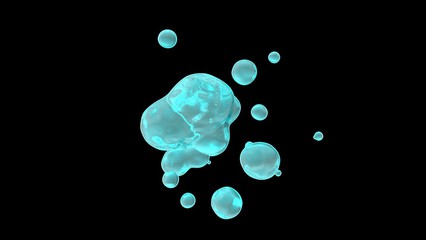
It may sound like a term straight out of a science fiction program such as Star Trek, but liquid-liquid “phase separation” is actually one of the hot new topics in epigenetics. Phase separation of proteins with certain characteristics leads to the formation of biomolecular liquid “droplets” that concentrate the levels of some proteins/factors while excluding the presence of others. An “Original Series” of Epigenie articles discussed the relevance of this phenomenon in regulating m6A-methylated mRNA transcription through the YTHDF proteins and the formation of heterochromatin by HP1 proteins. Now, “Next Generation” research from a team of “Enterprise”-ing researchers led by Alwin Köhler (Medical University of Vienna, Austria) have made an amazing phase separation-related “Discovery” during their analysis of Histone H2B ubiquitination in yeast!
Histone H2B monoubiquitination at lysine 123 in yeast occurs across promoter, gene body, and termination regions of most genes and exerts transcriptional effects by regulating nucleosome core particle assembly, stability, and histone methylation. In their fascinating new study, the team now establishes that liquid-liquid phase separation of ubiquitination-associated factors creates a chromatin-associated epigenetic ‘reaction chamber’ that promotes the ubiquitination of histone H2B along gene bodies.
Let´s move from science fiction to science fact, and hear all the details regarding this new study from Gallego and Colleagues:
- The authors found that Lge1, which possesses an intrinsically disordered region that can undergo liquid-liquid phase separation, acts as a scaffolding protein and binds the Bre1 E3 ubiquitin ligase
- A resulting condensate forms, which is comprised of a core of Lge1 encapsulated by an outer catalytic shell of Bre1, that recruits both the Rad6 E2 ubiquitin-conjugating enzyme and the nucleosomal substrate into the condensate
- This spatially organized reaction chamber confines Bre1 and Rad6 in a small space at high concentration to accelerate the ubiquitination of H2B to shape gene architecture and expression
- In vivo, the expression of an Lge1 form that lacks the intrinsically disordered condensate-forming region reduces the ubiquitination of H2B in gene bodies beyond the first nucleosome downstream of the transcription start site
- Fascinatingly, the human orthologues of Bre1 (RNF20/RNF40) copurify with WAC, a protein with no sequence similarity but a similar domain organization to Lge1
- Mutations to WAC lead to a neurodevelopmental disorder called DeSanto-Shinawi syndrome, suggesting that a failure to undergo liquid-liquid phase separation may result in the development of disease
From science fiction to science fact – the data described provides evidence that liquid-liquid phase separation helps to form layered condensates of histone-modifying enzymes that generate a chromatin-associated ‘reaction chamber’ to promote enhanced ubiquitination activity along gene bodies. Fascinatingly, the authors also suggest that reaction chamber formation by liquid-liquid phase separation may occur in human cells, and impairments to this process may prompt the onset of neurological disease.
“Working with budding yeast as a model organism gave us unprecedented access to manipulating and understanding the chemistry that allows layered liquids to function in the nucleus” said Köhler “And we also realized a potential link to human disease”.
You don´t have to travel into “Deep Space (9)” to see this fascinating new study, just “make it so” and “Voyage-r” over to Nature, March 2020!












